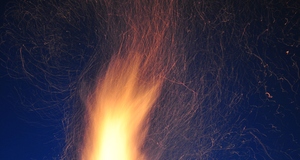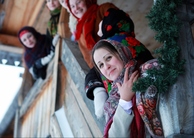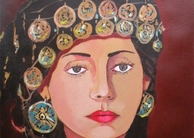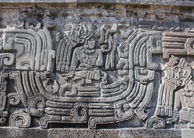Student VoicesHuman Rights in Chile: Remembrance and ReckoningActions and ActorsIn “The Multicultural Paradigm: An Open Letter to the National Arts Community,” Latino performance artist, Guillermo Gomez-Pena states, “In Latin America, the artist has multiple roles. He/she is not just an image-maker or a marginal genius, but a social thinker/educator/counter-journalist/civilian diplomat/human rights observer. His/her activities take place in the center of society and not in specialized corners.” (22) Ariel Dorfman’s La Muerte y La Doncella (Death and the Maiden) is one rendering by a Chilean artist of the trauma of torture in Chile’s recent history. In this case, the medium is theatre (produced on Broadway, featuring Glenn Close, Gene Hackman, and Richard Dreyfuss), and later film (directed by Roman Polanski, featuring Sigourney Weaver, Ben Kingsley, and Stuart Wilson). Dorfman was one of many artists effected by the military coup in 1973, and like many of his contemporaries, lived in exile many years. Chile’s national theatre scene has had a long tradition of closely mirroring its socio-political world, as well as being directly involved in its production in terms of political activism. What was largely traditional theatre broke away from traditional themes, advocating social progression and reform as early as the 1950s; when Allende’s United Front party was gaining political footholds, the theatre movement was working with collective creation, where traditional theatrical hierarchies— such as director, playwright, actor— were abolished and community effort was the essence of production. (see Mary de Luz Hurtado)In Dorfman’s play, the female protagonist encounters her former torturer and according to one account, “The play is about three people who, after surviving through a hellish experience, are reunited by chance, years later, to stage a seemingly endless ritual of guilt, intolerance and punishment.” (Martinez) The artist community in Chile was just one of many social groups to be exposed to torture and repression; many who fled considered themselves lucky to be exiled. As for the national theatre scene? According to one source, following the coup, when theatre resumed productions, “classics” were reintroduced, along with the disappearance of collective creation. (Maria de La Luz Hurtado) It is interesting to consider art mirroring reality, particularly when understanding the production of memory, free expression, and the everyday ritual of political, social, and legal life within a society. Further, when viewing the social reality of a given nation, the idea of performance gains multiple meanings. Within performance referring to physical action, there is the significance of the body and all of the ways it is used and defined as a political entity. It is ironic that during times of political repression, those who use their bodies to express political freedom are often the most targeted. In describing the measures of the dictatorship, one source states:
In an account given about the tragedy and treatment of Victor Jarra describes how on Wednesday, September 12th he was taken to the Chile Stadium, along with employees and students of the Technical University:
Additionally, there is the consideration of what it is to be an “actor,” as in the case of “performing a duty,” or to be impacted by the physical actions of others. Within human rights, legal culpability of the individual has so much to do with the performance or non-performance of certain actions, or simply action or non-action. “The [Torture] Convention calls for punishment not only of the person who actually carries out the act of torture, but of those who are complicit or participate in those acts.” (HRW, “The Pinochet Precendent”) In addition, in cases of torture, the body takes on a new significance as a way to access the individual and achieve political ends. Perhaps for a society to really address reparation where there has been torture, it is necessary to understand to extent of the trauma and the impact of such acts on a societal level, as discussed in the previous section. This is certainly necessary for a society to recognize that there have in fact occurred crimes against humanity, as ultimately came to be addressed in the case against Pinochet in 1998-99, involving the governments of the U.K. and Spain. Accounts given by victims of human rights abuses in Chile have helped reveal the brutality of the regime, and the full extent of its terror, both nationally and internationally:
As in human rights abuses in other countries, the physical degradation of torture as an acknowledged reality, given by survivors and witnesses, leads to a push for accountability of human actors. In Chile, transitioning into democracy included the formation of a Truth and Reconciliation Commission in 1990. One goal of such an institution was to provide accountability for human rights abuses that had occurred. In attaining accountability there was an acknowledgement of physical realities— that no matter what the abstract moral or political situation, that so many people had died, that such-and-such physical abuse had occurred, that this number of people had disappeared. The military coup in Chile and the move back into democracy may both be understood as examples of institutional crises. Correspondingly, however, are the actions of “human agencies,” that allow or promote construction or deconstruction:
The role of the worker in Chile changed tremendously during the years of the coup, perhaps most significantly politically in the abolition of powerful unions and other organizations that were basically prohibited during the first years of the dictatorship. Indeed, the role of the worker is a fact that is often ignored by economists who buy into upholding the Chilean economy as an example of “miracle” economics, as is discussed more later. In implementing its economic “shock treatment” to reverse the socialist reforms of previous presidencies, the dictatorship repeatedly terrorized the population:
In the late ‘70s, when Pinochet started to allow for more political freedom, labor unions and political parties were once again legalized, although the under tight restrictions and often with the leadership appointed by the dictatorship. Manuel Bustos Huerta is a Chilean activist and worker who was arrested in September, 1973 and taken to the National Stadium. In his account of life in modern Chile, given in the early ‘80s, Huerta concludes that “the union movement is practically dead, and he realizes that many workers have stopped reacting because they fear oppression, unemployment, and finally the violence involved in protest.” (Politzer, 174) He describes the scene of institutional transformation that began on September 11, 1973 when he and fellow workers on their way to a textile factory saw soldiers in the streets and “had no idea about the coup.” They thought it could have been a military operation searching for illegal weapons:
Soon after, the bombardment of the presidential palace took place. On September 12th, soldiers entered the factory where there were arrests and much violence, taking the workers to the Chile Stadium, where many were being held. He was detained until December 22 or 23, and was eventually released, surviving to tell the tale. In another account from the same time, “To disappear is not to die,” a mother tells of her searches for a missing son arrested in 1974 and her legal battles in the days before the Truth and Reconciliation Commission. Her story illustrates the extent the “reign of terror” had on people’s lives; in some of her contact with other individuals who had family members disappear there were those whose whole family was missing, including extended family. The disappearances created a presence of absence for many people, especially women, who had no news of their loved ones, and consequently no finality to their mourning, as in the case of Elsa Esquivel Rojo searching for her son Lucho. For years, she searched sites and detention centers with the hopes of finding him:
The artist Sting’s song “They Dance Alone,” speaks of the plight of mothers of the disappeared in the Southern Cone, with lyrics that fit Elsa’s years of incomplete mourning and loneliness: “They dance with their husbands, dancing with their sons, they dance alone...”Continued on Next Page » Suggested Reading from Inquiries Journal
Inquiries Journal provides undergraduate and graduate students around the world a platform for the wide dissemination of academic work over a range of core disciplines. Representing the work of students from hundreds of institutions around the globe, Inquiries Journal's large database of academic articles is completely free. Learn more | Blog | Submit Latest in Anthropology |














